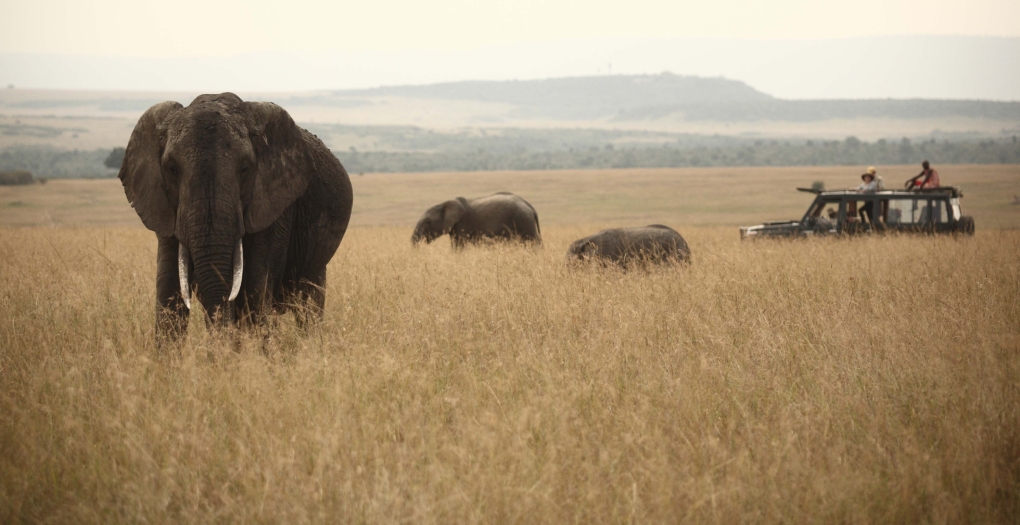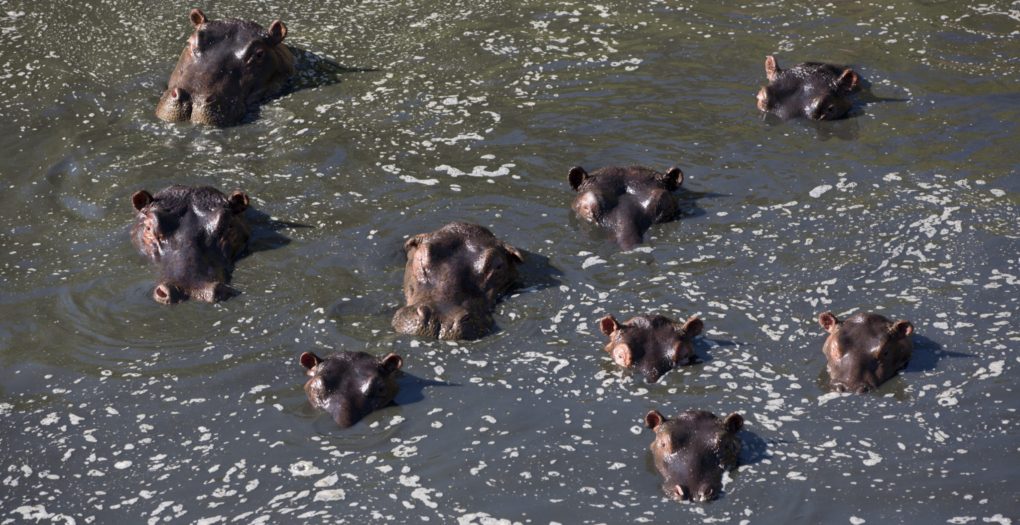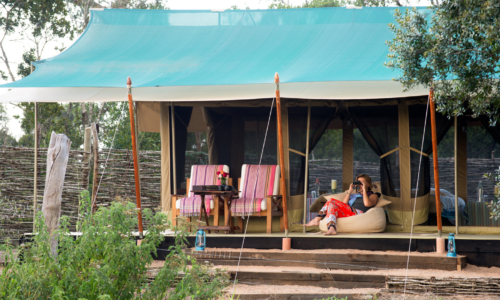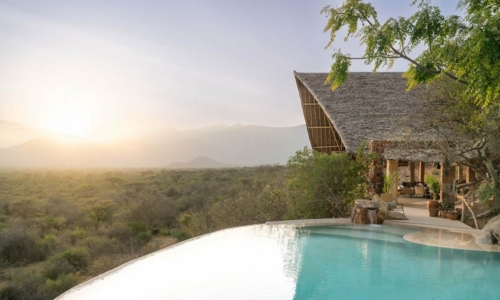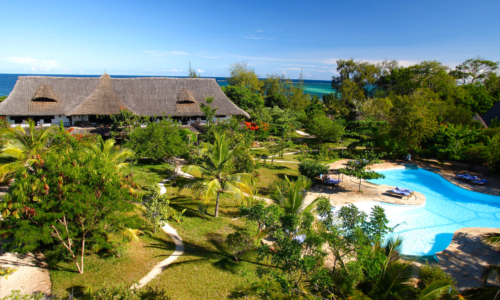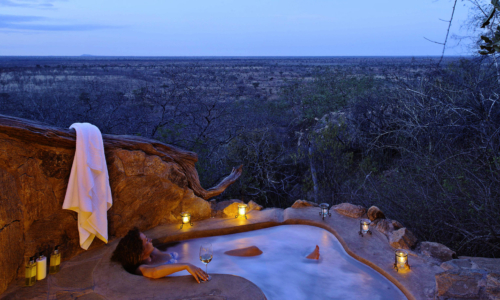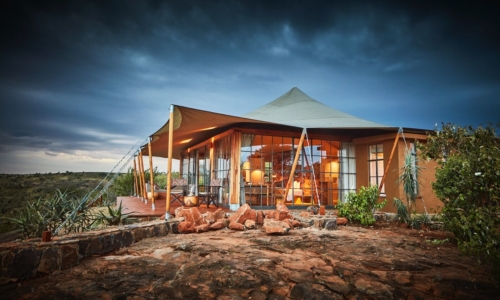Known as the jewel of Kenya’s wildlife viewing areas, the reserve was established in 1961 and covers 583 square miles. Unlike most other national parks in Kenya, the Maasai Mara National Reserve is administered by local authorities, giving the native Maasai people an integral part in the running of the park and protection of the wildlife. The Maasai Mara encompasses four different kinds of topography from sandy soil and small bushes to the east, to the Siria Escarpment forming a spectacular plateau on the western boundary, to lush grasslands and woodlands around the Mara River, to wide-open plains with scattered bushes making up the largest part of the reserve.
One of the most impressive natural spectacles in the world is the great migration which takes place each July and October between the Mara and Serengeti ecosystems. Crossing the plains in search of fresh pasture, 1,300,000 wildebeest, half a million Thomson’s gazelles, 200,000 zebra, and hundreds of thousands of other plains game participate in this phenomenon. Of course, predators such as lion and hyena follow the herds, hoping to prey on the young calves, aged wildebeest, and straggling animals.
The sheer concentration and diversity of wildlife provide unparalleled viewing opportunities for visitors. All of Africa’s “big five” call the Maasai Mara home. In addition, many antelope species flourish including Grant’s gazelles, impalas, duikers, Coke’s hartebeests, and roan antelopes. Hippopotamus and Nile crocodile inhabit the Mara and Talek rivers, which are the major suppliers of fresh water to the reserve. Other magnificent animals abound, including cheetah, jackal, and bat-eared fox.
There are plenty of activities provided by the safari camps in the region center around wildlife viewing for visitors to enjoy the reserve. Most camps offer daily and nightly game drives in open 4×4 vehicles led by expert guides usually from the Maasai people themselves. Walking safaris take a more intimate and detailed look at the land and animals with local guides teaching tracking skills. With around 500 birds species living here, bird watching is a popular attraction. Horseback and camel-back safaris mimic the explorers and missionaries of old for a unique trek across the land. For a spectacular aerial view hot-air balloon safaris lift the spirits and the body above the wide savanna. Cultural visits to traditional Maasai village are a great way to learn about local life and traditional customs.


- Amboseli Serena Safari Lodge
- Basecamp Masai Mara
- Bateleur Camp
- Campi ya Kanzi
- Cottar’s 1920s Safari Camp
- Deloraine House
- Eagle View
- Elephant Bedroom Camp
- Elephant Pepper Camp
- Elsa’s Kopje
- Emboo
- Encounter Mara
- Governors’ Camp
- Governors’ Private Camp
- Hemingways Ol Seki Mara Camp
- House in the Wild
- Il Moran Camp
- Il Ngwesi
- Joy’s Camp
- Kicheche Bush
- Kicheche Laikipia
- Kicheche Mara
- Kicheche Valley
- Kichwa Tembo Tented Camp
- Kifaru House Lewa
- Kilaguni Serena Safari Lodge
- Kinondo Kwetu
- Kitich Camp
- Kitirua Plains Lodge
- Lake Elmenteita Serena Camp
- Laragai House
- Leopard Hill
- Lewa House
- Lewa Private Wilderness
- Lewa Safari Camp
- Lewa Wilderness Lodge
- Little Governors’ Camp
- Loisaba Lodo Springs
- Loisaba Star Beds
- Loisaba Tented Camp
- Loldia House
- Mahali Mzuri
- Mara Expedition Camp
- Mara Nyika
- Mara Plains Camp
- Mara Serena Safari Lodge
- Mara Toto Tree Camp
- Mfangano Island Camp
- Naboisho Camp
- Ngare Serian
- Offbeat Mara Camp
- Ol Donyo Lodge
- Ol Jogi
- Ol Pejeta Bush Camp
- Ol Pejeta House
- Olare Mara
- Ololo Safari Lodge
- Olonana
- Olonana – Geoffrey Kent Suite
- Rekero Camp
- Reteti House
- Sabuk Lodge
- Sala’s Camp
- Sand River Masai Mara
- Sarara Camp
- Sarara Treehouses
- Sarara Wilderness
- Saruni Mara
- Saruni Rhino
- Saruni Samburu
- Saruni Wild
- Sasaab Camp
- Segera Retreat
- Serian The Original
- Serian’s Nkorombo
- Sirikoi
- Solio Lodge
- Sosian Lodge
- Speke’s Camp
- Tambarare
- Tangulia Mara
- Tawi Lodge
- Tortilis Camp
- Wilderness Mara
- Amboseli Serena Safari Lodge
- Basecamp Masai Mara
- Bateleur Camp
- Campi ya Kanzi
- Cottar’s 1920s Safari Camp
- Deloraine House
- Eagle View
- Elephant Bedroom Camp
- Elephant Pepper Camp
- Elsa’s Kopje
- Emboo
- Encounter Mara
- Governors’ Camp
- Governors’ Private Camp
- Hemingways Ol Seki Mara Camp
- House in the Wild
- Il Moran Camp
- Il Ngwesi
- Joy’s Camp
- Kicheche Bush
- Kicheche Laikipia
- Kicheche Mara
- Kicheche Valley
- Kichwa Tembo Tented Camp
- Kifaru House Lewa
- Kilaguni Serena Safari Lodge
- Kinondo Kwetu
- Kitich Camp
- Kitirua Plains Lodge
- Lake Elmenteita Serena Camp
- Laragai House
- Leopard Hill
- Lewa House
- Lewa Private Wilderness
- Lewa Safari Camp
- Lewa Wilderness Lodge
- Little Governors’ Camp
- Loisaba Lodo Springs
- Loisaba Star Beds
- Loisaba Tented Camp
- Loldia House
- Mahali Mzuri
- Mara Expedition Camp
- Mara Nyika
- Mara Plains Camp
- Mara Serena Safari Lodge
- Mara Toto Tree Camp
- Mfangano Island Camp
- Naboisho Camp
- Ngare Serian
- Offbeat Mara Camp
- Ol Donyo Lodge
- Ol Jogi
- Ol Pejeta Bush Camp
- Ol Pejeta House
- Olare Mara
- Ololo Safari Lodge
- Olonana
- Olonana – Geoffrey Kent Suite
- Rekero Camp
- Reteti House
- Sabuk Lodge
- Sala’s Camp
- Sand River Masai Mara
- Sarara Camp
- Sarara Treehouses
- Sarara Wilderness
- Saruni Mara
- Saruni Rhino
- Saruni Samburu
- Saruni Wild
- Sasaab Camp
- Segera Retreat
- Serian The Original
- Serian’s Nkorombo
- Sirikoi
- Solio Lodge
- Sosian Lodge
- Speke’s Camp
- Tambarare
- Tangulia Mara
- Tawi Lodge
- Tortilis Camp
- Wilderness Mara

Known as the jewel of Kenya’s wildlife viewing areas, the reserve was established in 1961 and covers 583 square miles. Unlike most other national parks in Kenya, the Maasai Mara National Reserve is administered by local authorities, giving the native Maasai people an integral part in the running of the park and protection of the wildlife. The Maasai Mara encompasses four different kinds of topography from sandy soil and small bushes to the east, to the Siria Escarpment forming a spectacular plateau on the western boundary, to lush grasslands and woodlands around the Mara River, to wide-open plains with scattered bushes making up the largest part of the reserve.
One of the most impressive natural spectacles in the world is the great migration which takes place each July and October between the Mara and Serengeti ecosystems. Crossing the plains in search of fresh pasture, 1,300,000 wildebeest, half a million Thomson’s gazelles, 200,000 zebra, and hundreds of thousands of other plains game participate in this phenomenon. Of course, predators such as lion and hyena follow the herds, hoping to prey on the young calves, aged wildebeest, and straggling animals.
The sheer concentration and diversity of wildlife provide unparalleled viewing opportunities for visitors. All of Africa’s “big five” call the Maasai Mara home. In addition, many antelope species flourish including Grant’s gazelles, impalas, duikers, Coke’s hartebeests, and roan antelopes. Hippopotamus and Nile crocodile inhabit the Mara and Talek rivers, which are the major suppliers of fresh water to the reserve. Other magnificent animals abound, including cheetah, jackal, and bat-eared fox.
There are plenty of activities provided by the safari camps in the region center around wildlife viewing for visitors to enjoy the reserve. Most camps offer daily and nightly game drives in open 4×4 vehicles led by expert guides usually from the Maasai people themselves. Walking safaris take a more intimate and detailed look at the land and animals with local guides teaching tracking skills. With around 500 birds species living here, bird watching is a popular attraction. Horseback and camel-back safaris mimic the explorers and missionaries of old for a unique trek across the land. For a spectacular aerial view hot-air balloon safaris lift the spirits and the body above the wide savanna. Cultural visits to traditional Maasai village are a great way to learn about local life and traditional customs.

- Amboseli Serena Safari Lodge
- Basecamp Masai Mara
- Bateleur Camp
- Campi ya Kanzi
- Cottar’s 1920s Safari Camp
- Deloraine House
- Eagle View
- Elephant Bedroom Camp
- Elephant Pepper Camp
- Elsa’s Kopje
- Emboo
- Encounter Mara
- Governors’ Camp
- Governors’ Private Camp
- Hemingways Ol Seki Mara Camp
- House in the Wild
- Il Moran Camp
- Il Ngwesi
- Joy’s Camp
- Kicheche Bush
- Kicheche Laikipia
- Kicheche Mara
- Kicheche Valley
- Kichwa Tembo Tented Camp
- Kifaru House Lewa
- Kilaguni Serena Safari Lodge
- Kinondo Kwetu
- Kitich Camp
- Kitirua Plains Lodge
- Lake Elmenteita Serena Camp
- Laragai House
- Leopard Hill
- Lewa House
- Lewa Private Wilderness
- Lewa Safari Camp
- Lewa Wilderness Lodge
- Little Governors’ Camp
- Loisaba Lodo Springs
- Loisaba Star Beds
- Loisaba Tented Camp
- Loldia House
- Mahali Mzuri
- Mara Expedition Camp
- Mara Nyika
- Mara Plains Camp
- Mara Serena Safari Lodge
- Mara Toto Tree Camp
- Mfangano Island Camp
- Naboisho Camp
- Ngare Serian
- Offbeat Mara Camp
- Ol Donyo Lodge
- Ol Jogi
- Ol Pejeta Bush Camp
- Ol Pejeta House
- Olare Mara
- Ololo Safari Lodge
- Olonana
- Olonana – Geoffrey Kent Suite
- Rekero Camp
- Reteti House
- Sabuk Lodge
- Sala’s Camp
- Sand River Masai Mara
- Sarara Camp
- Sarara Treehouses
- Sarara Wilderness
- Saruni Mara
- Saruni Rhino
- Saruni Samburu
- Saruni Wild
- Sasaab Camp
- Segera Retreat
- Serian The Original
- Serian’s Nkorombo
- Sirikoi
- Solio Lodge
- Sosian Lodge
- Speke’s Camp
- Tambarare
- Tangulia Mara
- Tawi Lodge
- Tortilis Camp
- Wilderness Mara
- Amboseli Serena Safari Lodge
- Basecamp Masai Mara
- Bateleur Camp
- Campi ya Kanzi
- Cottar’s 1920s Safari Camp
- Deloraine House
- Eagle View
- Elephant Bedroom Camp
- Elephant Pepper Camp
- Elsa’s Kopje
- Emboo
- Encounter Mara
- Governors’ Camp
- Governors’ Private Camp
- Hemingways Ol Seki Mara Camp
- House in the Wild
- Il Moran Camp
- Il Ngwesi
- Joy’s Camp
- Kicheche Bush
- Kicheche Laikipia
- Kicheche Mara
- Kicheche Valley
- Kichwa Tembo Tented Camp
- Kifaru House Lewa
- Kilaguni Serena Safari Lodge
- Kinondo Kwetu
- Kitich Camp
- Kitirua Plains Lodge
- Lake Elmenteita Serena Camp
- Laragai House
- Leopard Hill
- Lewa House
- Lewa Private Wilderness
- Lewa Safari Camp
- Lewa Wilderness Lodge
- Little Governors’ Camp
- Loisaba Lodo Springs
- Loisaba Star Beds
- Loisaba Tented Camp
- Loldia House
- Mahali Mzuri
- Mara Expedition Camp
- Mara Nyika
- Mara Plains Camp
- Mara Serena Safari Lodge
- Mara Toto Tree Camp
- Mfangano Island Camp
- Naboisho Camp
- Ngare Serian
- Offbeat Mara Camp
- Ol Donyo Lodge
- Ol Jogi
- Ol Pejeta Bush Camp
- Ol Pejeta House
- Olare Mara
- Ololo Safari Lodge
- Olonana
- Olonana – Geoffrey Kent Suite
- Rekero Camp
- Reteti House
- Sabuk Lodge
- Sala’s Camp
- Sand River Masai Mara
- Sarara Camp
- Sarara Treehouses
- Sarara Wilderness
- Saruni Mara
- Saruni Rhino
- Saruni Samburu
- Saruni Wild
- Sasaab Camp
- Segera Retreat
- Serian The Original
- Serian’s Nkorombo
- Sirikoi
- Solio Lodge
- Sosian Lodge
- Speke’s Camp
- Tambarare
- Tangulia Mara
- Tawi Lodge
- Tortilis Camp
- Wilderness Mara









